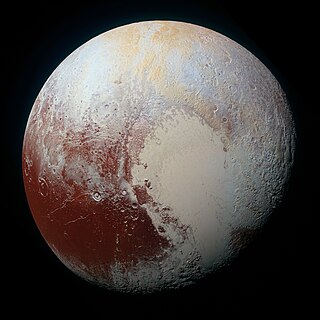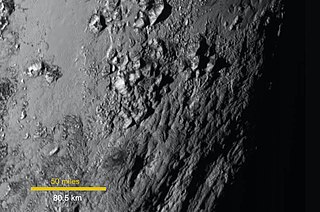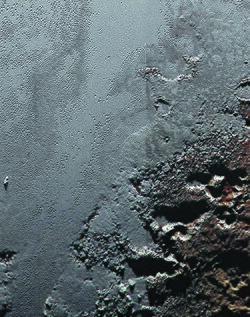
Pluto is a dwarf planet in the Kuiper belt, a ring of bodies beyond the orbit of Neptune. It is the ninth-largest and tenth-most-massive known object to directly orbit the Sun. It is the largest known trans-Neptunian object by volume, by a small margin, but is less massive than Eris. Like other Kuiper belt objects, Pluto is made primarily of ice and rock and is much smaller than the inner planets. Pluto has roughly one-sixth the mass of Earth's moon, and one-third its volume.

Cthulhu is a cosmic entity created by writer H. P. Lovecraft. It was introduced in his short story "The Call of Cthulhu", published by the American pulp magazine Weird Tales in 1928. Considered a Great Old One within the pantheon of Lovecraftian cosmic entities, this creature has since been featured in numerous popular culture references. Lovecraft depicts it as a gigantic entity worshipped by cultists, in the shape of a green octopus, dragon, and a caricature of human form. The Lovecraft-inspired universe, the Cthulhu Mythos, where it exists with its fellow entities, is named after it.

Mandaeans, also known as Mandaean Sabians or simply as Sabians, are an ethnoreligious group who are followers of Mandaeism. They believe that John the Baptist was the final and most important prophet. They may have been among the earliest religious groups to practice baptism, as well as among the earliest adherents of Gnosticism, a belief system of which they are the last surviving representatives today. The Mandaeans were originally native speakers of Mandaic, an Eastern Aramaic language, before they nearly all switched to Mesopotamian Arabic or Persian as their main language.

The geology of Pluto consists of the characteristics of the surface, crust, and interior of Pluto. Because of Pluto's distance from Earth, in-depth study from Earth is difficult. Many details about Pluto remained unknown until 14 July 2015, when New Horizons flew through the Pluto system and began transmitting data back to Earth. When it did, Pluto was found to have remarkable geologic diversity, with New Horizons team member Jeff Moore saying that it "is every bit as complex as that of Mars". The final New Horizons Pluto data transmission was received on 25 October 2016. In June 2020, astronomers reported evidence that Pluto may have had a subsurface ocean, and consequently may have been habitable, when it was first formed.

Aphrodite Terra is one of the three continental regions on the planet Venus, the others being Ishtar Terra and Lada Terra. It is named for Aphrodite, the Greek equivalent of the goddess Venus, and is found near the equator of the planet. Aphrodite Terra is about half the size of Africa, making it the largest of the terrae.
Krun or Akrun is a Mandaean lord of the underworld. According to Mandaean cosmology, he dwells in the lowest depths of creation, supporting the entirety of the physical world.
In Mandaeism, Rūha is the queen of the World of Darkness or underworld. She rules the underworld together with her son Ur, the king of the World of Darkness, and her entourage of the seven planets and twelve constellations, who are also her offspring with Ur.

Tombaugh Regio, sometimes nicknamed "Pluto's heart" after its shape, is the largest bright surface feature of the dwarf planet Pluto. It lies just north of Pluto's equator, to the northeast of Belton Regio and to the northwest of Krun Macula, which are both dark features. Its western lobe, a 1,000 km (620 mi)-wide plain of nitrogen and other ices lying within a basin, is named Sputnik Planitia. The eastern lobe consists of high-albedo uplands thought to be coated by nitrogen transported through the atmosphere from Sputnik Planitia, and then deposited as ice. Some of this nitrogen ice then returns to Sputnik Planitia via glacial flow. The region is named after Clyde Tombaugh, the discoverer of Pluto.

Belton Regio is a prominent surface feature of the dwarf planet Pluto. It is an elongated dark region along Pluto's equator, 2,990 km (1,860 mi) long and one of the darkest features on its surface.

The geography of Pluto is mainly focused the distribution of physical features across Pluto. On 14 July 2015, the New Horizons spacecraft became the first spacecraft to fly by Pluto. During its brief flyby, New Horizons made detailed geographical measurements and observations of Pluto and its moons.

The Tenzing Montes are a range of icy mountains on Pluto, bordering the southwest region of Sputnik Planitia and the nearby Hillary Montes and Wright Mons. With peaks reaching 6.2 km in height, they are the highest mountain range on Pluto, and also the steepest, with a mean slope of 19.2 degrees.

Ala is the smallest of the "Brass Knuckles", a series of equatorial dark regions on Pluto. It is named after Ala "earth", the chthonic and most important deity of the Igbo people.

Balrog Macula is the largest of the "Brass Knuckles", a series of equatorial dark regions on Pluto.

Vucub-Came is one of the "Brass Knuckles", a series of equatorial dark regions on Pluto. It is named after Wuquub' Kameh "Seven Death", one of the Quiché death gods in the Popol Vuh.

Hun-Came is one of the "Brass Knuckles", a series of equatorial dark regions on Pluto. It is named after Jun Kameh "One Death", one of the Quiché death gods in the Popol Vuh.

Meng-pʻo is the easternmost of the "Brass Knuckles", a series of equatorial dark regions on Pluto. Meng-pʻo straddles the zero meridian, directly under Pluto's tidally locked moon Charon and just west of the tail of the "Whale", Belton Regio. It is named after Meng Po, the Chinese underworld deity of forgetfulness.

The Hillary Montes or are a mountain range that reach 3.5 km above the surface of the dwarf planet Pluto. They are located northwest of Tenzing Montes in the southwest border area of Sputnik Planitia in the south of Tombaugh Regio. The Hillary Montes were first viewed by the New Horizons spacecraft on 14 July 2015, and announced by NASA on 24 July 2015.

The climate of Pluto concerns the atmospheric dynamics, weather, and long-term trends on the dwarf planet Pluto. Five climate zones are assigned on the dwarf planet: tropics, arctic, tropical arctic, diurnal, and polar. These climate zones are delineated based on astronomically defined boundaries or sub-solar latitudes, which are not associated with the atmospheric circulations on the dwarf planet. Charon, the largest moon of Pluto, is tidally locked with it, and thus has the same climate zone structure as Pluto itself.
The Baptism of Hibil Ziwa or Diwan Maṣbuta ḏ-Hibil Ziwa is a Mandaean illustrated scroll. It describes the soteriological descent of Hibil Ziwa to the World of Darkness, and his baptisms before and after. The scroll is essentially also a commentary on the masbuta, or Mandaean ritual baptism.
In Mandaeism, Hibil or Hibil Ziwa is an uthra from the World of Light. Hibil is considered to be the Mandaean equivalent of Abel.
















